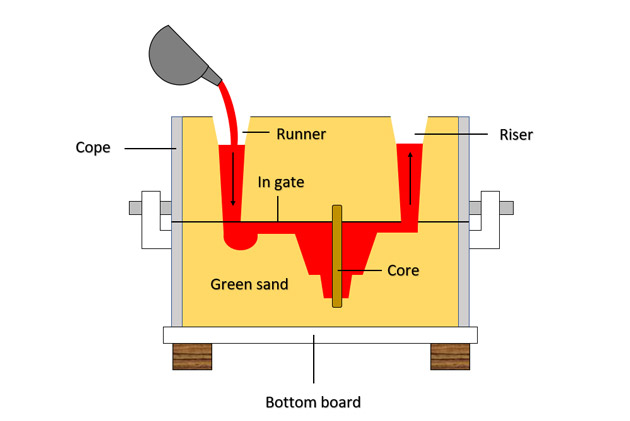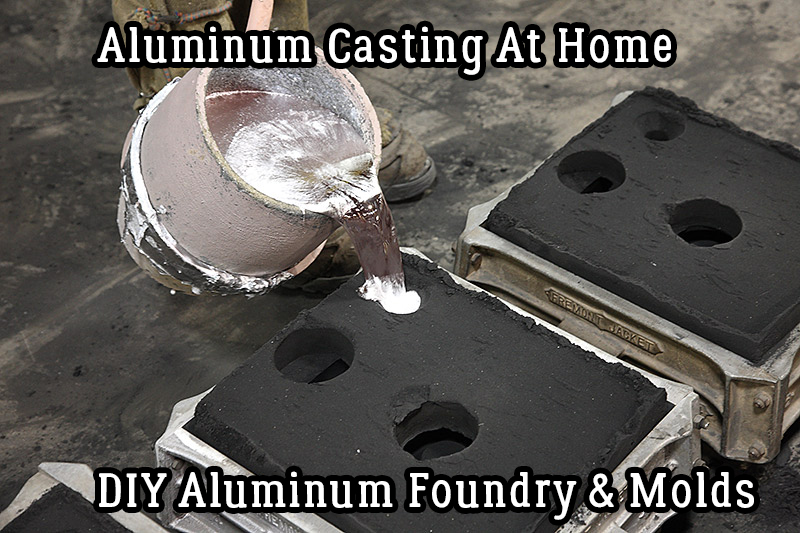Uncovering the strengths of Aluminum Foundry Wisconsin in casting work
Exactly How Aluminum Foundry Contributes to Advancements in Aerospace Engineering
Aluminum factories are indispensable to improvements in aerospace design. They create light-weight, high-strength components that are vital for contemporary aircraft. Through advanced casting strategies, these foundries create complex geometries that enhance architectural integrity. In addition, the growth of superior Aluminum alloys supports the market's focus on fuel effectiveness and sustainability. Nonetheless, obstacles continue to be in the production procedure. Understanding these elements reveals the profound impact of Aluminum on aeronautics's future.
The Relevance of Lightweight Products in Aerospace Style
As the aerospace industry remains to develop, the relevance of lightweight materials comes to be significantly noticeable. The demand for efficiency and sustainability drives designers to focus on the usage of products that decrease overall weight without compromising structural stability. Light-weight materials, especially Aluminum, play an essential function in enhancing gas performance, improving haul capability, and boosting the general efficiency of airplane.
The combination of these materials allows for cutting-edge designs, enabling manufacturers to create more aerodynamic shapes that can hold up against severe conditions. The reduction in weight not just decreases operational prices however also adds to a reduced ecological footprint, lining up with worldwide initiatives toward sustainability in aeronautics.
Advanced Casting Techniques in Aluminum Foundries
Advanced casting methods in Aluminum factories play a vital function in aerospace engineering by allowing the manufacturing of light-weight and specific elements. Technologies in mold and mildew design and accuracy casting processes are necessary in attaining perfect performance and architectural honesty. Additionally, the growth of light-weight alloys enhances the overall performance and effectiveness of aerospace applications.
Cutting-edge Mold Design
Innovative mold and mildew style plays a vital role in the performance and efficiency of Aluminum foundries, specifically within the aerospace industry. By leveraging advanced products and strategies, modern mold and mildews can be crafted to hold up against heats and pressures, making sure peak efficiency throughout the spreading process. These layouts commonly incorporate complex geometries that permit the production of light-weight yet structurally sound components, crucial for aerospace applications. In addition, the use of computer-aided design (CAD) software program facilitates exact modeling, allowing foundries to refine and imitate mold layouts before physical manufacturing starts. This not only enhances the quality of actors parts yet additionally reduces waste and lead times, bring about substantial expense savings. Overall, ingenious mold design is a cornerstone of progress in Aluminum Foundry technology for aerospace design.
Precision Casting Processes
The efficiency of innovative mold designs seamlessly incorporates with accuracy casting processes, which are essential for creating premium Aluminum parts in aerospace design. These processes, consisting of sand spreading, pass away spreading, and investment casting, ensure the development of complicated geometries with tight tolerances. Advanced strategies like vacuum cleaner casting and stress pass away casting boost the integrity and surface finish of the final items. Accuracy casting lessens material waste while making best use of the mechanical buildings of Aluminum, vital for aerospace applications. Furthermore, utilizing real-time surveillance and progressed simulation devices throughout the casting process enables instant changes, causing enhanced quality assurance. Collectively, these precision casting processes placement Aluminum shops at the center of aerospace innovation, supporting the industry's demand for integrity and performance.
Light-weight Alloy Growth
As aerospace designers look for to enhance fuel performance and performance, lightweight alloy growth comes to be an important focus in Aluminum factories. These factories employ innovative spreading techniques to create alloys that supply exceptional strength-to-weight ratios. Technologies in alloy structure, including the consolidation of aspects like lithium and magnesium, allow the manufacturing of products that withstand severe problems while minimizing general airplane weight. Techniques such as die spreading and investment spreading assist in the precision production of complicated forms, which are crucial for aerospace applications. Additionally, continuous research study intends to maximize these alloys for boosted mechanical buildings and increased longevity. By prioritizing light-weight alloy advancement, Aluminum factories significantly add to the development of aerospace design, leading the way for a lot more lasting and effective airplane styles.

Enhancing Structural Stability Through Aluminum Parts
Aluminum elements offer considerable benefits in improving structural honesty within aerospace design. Their light-weight nature adds to general effectiveness while preserving strength, which is vital for aircraft performance. Furthermore, the stress and anxiety resistance homes of Aluminum help guarantee the resilience and integrity of aerospace structures under numerous operational conditions.
Light-weight Product Perks
While standard materials often endanger weight for stamina, utilizing Aluminum elements in aerospace design supplies significant benefits in structural honesty. Aluminum's light-weight nature adds to total style effectiveness, enabling more streamlined aircraft that consume much less gas, therefore boosting sustainability. The product's superb strength-to-weight ratio warranties that components maintain resilience without adding unneeded mass. This top quality promotes improved performance and dexterity in trip, along with maximized haul capabilities. In addition, Aluminum's resistance to deterioration extends the life-span of aerospace structures, minimizing upkeep prices and boosting safety and security. As manufacturers progressively embrace Aluminum alloys, the aerospace industry experiences a transformative shift in the direction of a lot more reliable and reliable engineering services that prioritize both efficiency and environmental obligation.
Anxiety Resistance Characteristics
Various products have special residential properties, Aluminum's phenomenal anxiety resistance stands out as a crucial variable in boosting the architectural integrity of aerospace parts. This resistance plays a critical function in making certain that aircraft can endure different functional stresses, consisting of tiredness, effect, and environmental problems. Aluminum alloys, specifically crafted for aerospace applications, exhibit high tensile toughness while keeping light-weight qualities, enabling engineers to create extra effective frameworks - Aluminum Foundry. Additionally, the capacity of Aluminum to withstand cyclic loading without substantial contortion adds to the longevity and reliability of aerospace elements. As innovations continue in Aluminum Foundry strategies, the advancement of stress-resistant Aluminum components guarantees more improvements in efficiency, security, and efficiency throughout the aerospace industry, strengthening Aluminum's role as a favored material in modern-day design
Gas Efficiency Improvements Driven by Aluminum Innovations
As the aerospace market seeks to enhance gas efficiency, innovative uses of Aluminum have actually emerged as an important option. Aluminum's light-weight nature especially reduces aircraft weight, permitting lower gas usage during trip. This decrease in weight is crucial, as even small declines can lead to significant improvements in general gas economic climate.
Advanced Aluminum alloys, developed for enhanced toughness and resilience, enable makers to develop components that preserve structural integrity while lessening mass - Aluminum Foundry. Furthermore, the combination of Aluminum in airframes and engine components assists in boosted the rules of aerodynamics, adding to lowered drag and increased effectiveness
The adoption of Aluminum in aerospace not only satisfies index the demand for fuel-efficient style but additionally lines up with regulatory pressures for lower discharges. As these advancements continue to progress, they play a considerable function in setting new benchmarks for gas performance, making sure that the aerospace field can satisfy growing environmental and financial challenges.

The Duty of Aluminum in Sustainable Aeronautics Practices
The enhancing focus on sustainable air travel methods has actually positioned Aluminum as a vital product in the quest for greener aircraft layout. Known for its lightweight properties, Aluminum significantly reduces airplane weight, leading to reduced fuel intake and discharges. Its recyclability further enhances its sustainability profile, as Aluminum can be reused forever without loss of top quality. This characteristic sustains a circular economic situation within the aeronautics field, minimizing waste and resource exhaustion.
Additionally, developments in Aluminum alloys have improved their toughness and corrosion resistance, enabling longer solution life and minimized maintenance requirements. These innovations help with the growth of a lot more efficient aircraft frameworks, adding to general sustainability initiatives. In addition, Aluminum's thermal conductivity plays a vital duty in energy-efficient styles, boosting systems such as warmth exchangers. Jointly, these features emphasize Aluminum's essential function ahead of time sustainable air travel, lining up with global efforts aimed at lowering the environmental effect of flight.
Challenges Faced by Aluminum Foundries in Aerospace Manufacturing
While Aluminum shops play a vital function in aerospace production, they deal with considerable obstacles that can influence production performance and quality. One significant obstacle is the stringent quality control requirements required in the aerospace market. Any kind of flaw can jeopardize safety and performance, demanding strenuous assessment processes that expand production timelines. Furthermore, foundries often contend with rising and fall basic material costs, which can impact prices and productivity. The intricacy of Aluminum alloys utilized in aerospace applications further makes complex the production procedure, as specific solutions are essential for accomplishing wanted mechanical properties. Experienced labor lacks hinder the capacity to keep top quality production levels. Ultimately, environmental guidelines impose constraints on discharges and waste management, needing shops to buy lasting practices, which can be cost-prohibitive. These factors jointly produce a landscape where Aluminum foundries have to continually adapt to meet the advancing demands of aerospace production while making certain safety and compliance.
Future Patterns in Aluminum Applications for Aerospace Design
With advancements in technology and increasing demands for effectiveness, the future of Aluminum applications in aerospace design is poised for substantial change. The assimilation of cutting-edge Aluminum alloys and composites is anticipated to improve strength-to-weight ratios, resulting in more fuel-efficient aircraft designs. Furthermore, improvements in additive manufacturing strategies will permit the production of complex Aluminum structures that were previously difficult, maximizing efficiency and reducing waste.

Sustainable practices will certainly play an essential role, with an expanding focus on recycling Aluminum to lessen ecological impact. The aerospace sector is most likely to accept smarter producing procedures, such as automation and expert system, making sure better and accuracy in Aluminum parts. Cooperations between Aluminum shops and aerospace firms will cultivate research study and growth, leading the means for new applications that meet the strict needs of contemporary aerospace engineering. Overall, the future looks promising for Aluminum's role fit the skies
Often Asked Questions
What Are the Ecological Effects of Aluminum Production in Aerospace?
The environmental impacts of Aluminum production in aerospace consist of significant power usage, greenhouse gas discharges, and habitat interruption. In addition, mining processes can lead to dirt deterioration and water contamination, raising worries regarding sustainability and environmental equilibrium.
Just How Does Aluminum Contrast to Various Other Materials in Aerospace Applications?
Aluminum provides a special Look At This mix of lightweight residential or commercial properties, deterioration resistance, and cost-effectiveness compared to other materials. Its high strength-to-weight proportion makes it specifically useful for aerospace applications, improving fuel effectiveness and overall efficiency in airplane design.
What Certifications Do Aluminum Foundry Employees Demand for Aerospace Projects?
Aluminum Foundry workers call for specialized training in metallurgy and spreading techniques, along with expertise of aerospace sector standards. Certifications in quality control and safety and security procedures are also necessary to assure compliance with rigorous aerospace task requirements.
Exist Any Safety Interest In Making Use Of Aluminum in Aerospace Engineering?
Security problems relating to Aluminum in aerospace engineering include susceptibility to anxiety, fatigue, and rust cracks. Proper treatment and alloy choice are vital to reduce these threats, making certain structural integrity and overall safety and security in aerospace applications.
Just How Does Aluminum Recycling Benefit the Aerospace Industry?
Aluminum reusing considerably benefits the aerospace industry by minimizing material expenses, lessening ecological impact, and saving energy. This sustainable technique enhances the industry's performance while advertising using lightweight, high-performance parts in aircraft manufacturing.
Advanced casting methods in Aluminum shops play a vital role in aerospace engineering by allowing the manufacturing of specific and lightweight components. Innovative mold layout plays an essential role in the effectiveness and content efficiency of Aluminum foundries, specifically within the aerospace field. As aerospace designers seek to improve fuel effectiveness and performance, lightweight alloy development comes to be a vital emphasis in Aluminum shops. Aluminum alloys, specifically engineered for aerospace applications, exhibit high tensile strength while keeping lightweight attributes, allowing engineers to make a lot more effective structures. Cooperations between Aluminum factories and aerospace business will certainly cultivate research study and advancement, leading the method for brand-new applications that fulfill the rigorous demands of contemporary aerospace engineering.